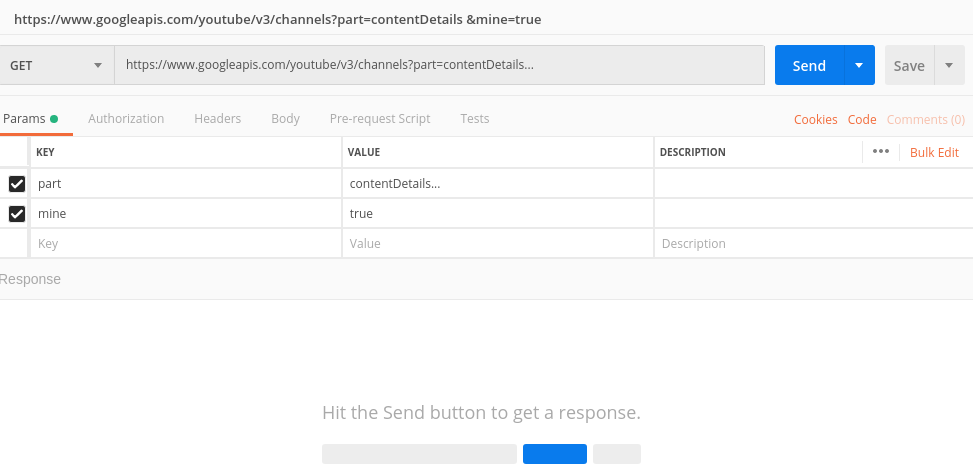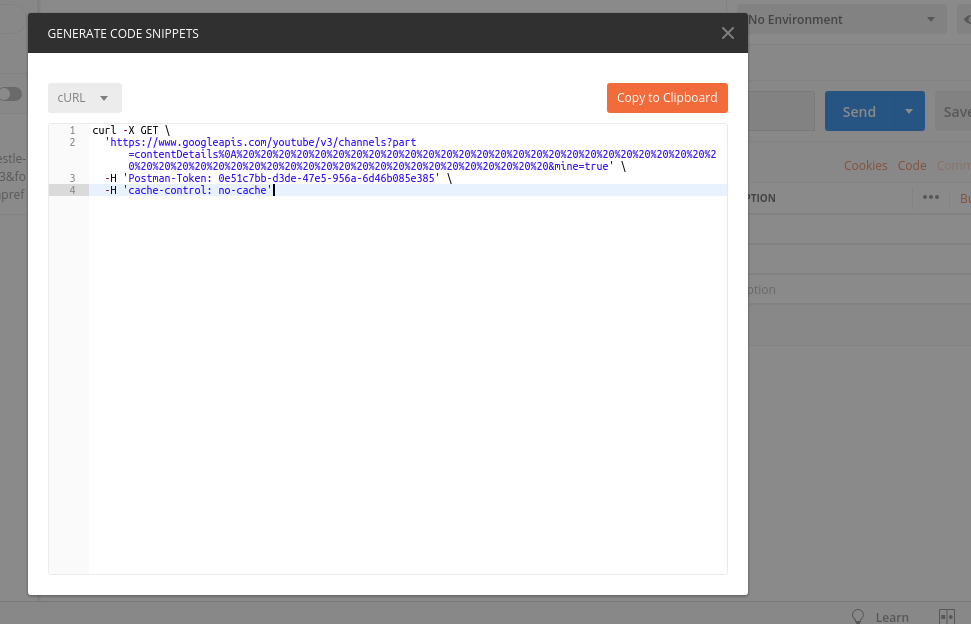I wish to send a header to my Apache server on a Linux box. How can I achieve this via a cURL call?
GET:
with JSON:
curl -i -H "Accept: application/json" -H "Content-Type: application/json" http://hostname/resource
with XML:
curl -H "Accept: application/xml" -H "Content-Type: application/xml" -X GET http://hostname/resource
POST:
For posting data:
curl --data "param1=value1¶m2=value2" http://hostname/resource
For file upload:
curl --form "[email protected]" http://hostname/resource
RESTful HTTP Post:
curl -X POST -d @filename http://hostname/resource
For logging into a site (auth):
curl -d "username=admin&password=admin&submit=Login" --dump-header headers http://localhost/Login
curl -L -b headers http://localhost/
Accept is meant for the client (asking/requesting), who wishes to have this, BUT the Header Content-Type is only the servers answer nothing more, it is not mistakenly the wish of the client: “I want this type of content” . Right? So for GET curl -i -H "Accept: application/json" http://hostname/resource should be it. Am I wrong? See developer.mozilla.org/en-US/docs/Web/HTTP/Headers/Content-Type «In responses, a Content-Type header tells the client what the content type of the returned content actually is.» –
Consequent Content-Type at the response. Not the request. Content-Type will always refer to type of data transmitted between two parties. If it is on request header, it means the client says 'Yeah I'm sending you data type application/json' to the server. If it is on response, it means the server says 'Now I'm sending you data type text/plain' to the client. –
Clinic -H/--header <header>
(HTTP) Extra header to use when getting a web page. You may specify
any number of extra headers. Note that if you should add a custom
header that has the same name as one of the internal ones curl would
use, your externally set header will be used instead of the internal
one. This allows you to make even trickier stuff than curl would
normally do. You should not replace internally set headers without
knowing perfectly well what you're doing. Remove an internal header
by giving a replacement without content on the right side of the
colon, as in: -H "Host:".
curl will make sure that each header you add/replace get sent with
the proper end of line marker, you should thus not add that as a
part of the header content: do not add newlines or carriage returns
they will only mess things up for you.
See also the -A/--user-agent and -e/--referer options.
This option can be used multiple times to add/replace/remove multi-
ple headers.
Example 1: Single Header
curl --header "X-MyHeader: 123" www.google.com
Example 2: Multiple Headers
curl --header "Accept: text/javascript" --header "X-Test: hello" -v www.google.com
You can see the request that curl sent by adding the -v option.
GET:
with JSON:
curl -i -H "Accept: application/json" -H "Content-Type: application/json" http://hostname/resource
with XML:
curl -H "Accept: application/xml" -H "Content-Type: application/xml" -X GET http://hostname/resource
POST:
For posting data:
curl --data "param1=value1¶m2=value2" http://hostname/resource
For file upload:
curl --form "[email protected]" http://hostname/resource
RESTful HTTP Post:
curl -X POST -d @filename http://hostname/resource
For logging into a site (auth):
curl -d "username=admin&password=admin&submit=Login" --dump-header headers http://localhost/Login
curl -L -b headers http://localhost/
Accept is meant for the client (asking/requesting), who wishes to have this, BUT the Header Content-Type is only the servers answer nothing more, it is not mistakenly the wish of the client: “I want this type of content” . Right? So for GET curl -i -H "Accept: application/json" http://hostname/resource should be it. Am I wrong? See developer.mozilla.org/en-US/docs/Web/HTTP/Headers/Content-Type «In responses, a Content-Type header tells the client what the content type of the returned content actually is.» –
Consequent Content-Type at the response. Not the request. Content-Type will always refer to type of data transmitted between two parties. If it is on request header, it means the client says 'Yeah I'm sending you data type application/json' to the server. If it is on response, it means the server says 'Now I'm sending you data type text/plain' to the client. –
Clinic In PHP:
curl_setopt($ch, CURLOPT_HTTPHEADER, array('HeaderName:HeaderValue'));
or you can set multiple:
curl_setopt($ch, CURLOPT_HTTPHEADER, array('HeaderName:HeaderValue', 'HeaderName2:HeaderValue2'));
Use -H or --header.
Man page: http://curl.haxx.se/docs/manpage.html#-H
GET (multiple parameters):
curl -X GET "http://localhost:3000/action?result1=gh&result2=ghk"
or
curl --request GET "http://localhost:3000/action?result1=gh&result2=ghk"
or
curl "http://localhost:3000/action?result1=gh&result2=ghk"
or
curl -i -H "Application/json" -H "Content-type: application/json" "http://localhost:3000/action?result1=gh&result2=ghk"
You can also send multiple headers, data (JSON for example), and specify Call method (POST,GET) into a single CUrl call like this:
curl -X POST(Get or whatever) \
http://your_url.com/api/endpoint \
-H 'Content-Type: application/json' \
-H 'header-element1: header-data1' \
-H 'header-element2: header-data2' \
......more headers................
-d '{
"JsonExArray": [
{
"json_prop": "1",
},
{
"json_prop": "2",
}
]
}'
I use Postman.
Execute whatever call you want to do. Then, postman provides a handy tool to show the curl code .
I've switched from curl to Httpie; the syntax looks like:
http http://myurl HeaderName:value
In case you want send your custom headers, you can do it this way:
curl -v -H @{'custom_header'='custom_header_value'} http://localhost:3000/action?result1=gh&result2=ghk
{'custom_header'='custom_header_value'}? –
Thelmathem In anaconda envirement through windows the commands should be: GET, for ex:
curl.exe http://127.0.0.1:5000/books
Post or Patch the data for ex:
curl.exe http://127.0.0.1:5000/books/8 -X PATCH -H "Content-Type: application/json" -d '{\"rating\":\"2\"}'
PS: Add backslash for json data to avoid this type of error => Failed to decode JSON object: Expecting value: line 1 column 1 (char 0)
and use curl.exe instead of curl only to avoid this problem:
Invoke-WebRequest : Cannot bind parameter 'Headers'. Cannot convert the "Content-Type: application/json" value of type
"System.String" to type "System.Collections.IDictionary".
At line:1 char:48
+ ... 0.1:5000/books/8 -X PATCH -H "Content-Type: application/json" -d '{\" ...
+ ~~~~~~~~~~~~~~~~~~~~~~~~~~~~~~~~
+ CategoryInfo : InvalidArgument: (:) [Invoke-WebRequest], ParameterBindingException
+ FullyQualifiedErrorId : CannotConvertArgumentNoMessage,Microsoft.PowerShell.Commands.InvokeWebRequestCommand
Here are the some curl commands for most common http methods.
Domain Object considered here is
@Data
@NoArgsConstructor
@AllArgsConstructor
@Document
@Validated
public class Movie {
@Id
private String id;
private String name;
@NotNull
private Integer year;
@NotNull
private List<String> cast;
private LocalDate release_date;
}
POST-CREATE-MOVIE
curl -i \
-d '{"id":1, "name": "Dhoom", "year":2004,"cast":["John Abraham", "Abhishek Bachan"],"release_date": "2004-06-15"}' \
-H "Content-Type: application/json" \
-X POST http://localhost:8080/v1/movies
GET-ALL-MOVIES
curl -i http://localhost:8080/v1/movies
GET-MOVIE-BY-ID
curl -i http://localhost:8080/v1/movies/1
PUT-UPDATE-MOVIE
curl -i \
-d '{"id":1, "name": "Dhoom", "year":2005,"cast":["John Abhraham", "Abhishek Bachhan", "Uday Chopra", "Isha Deol"],"release_date": "2005-03-25"}' \
-H "Content-Type: application/json" \
-X PUT http://localhost:8080/v1/movies/1
DELETE-MOVIE
curl -i -X DELETE http://localhost:8080/v1/movies/1
© 2022 - 2024 — McMap. All rights reserved.


